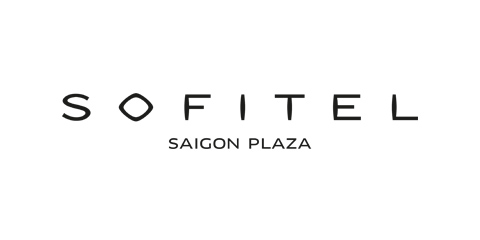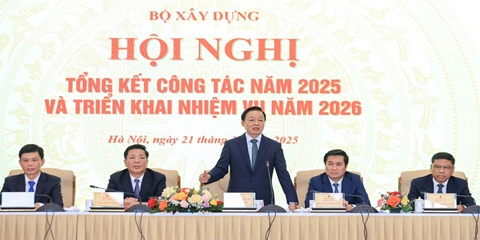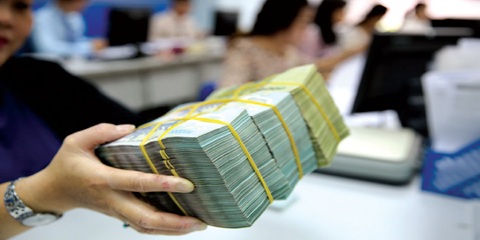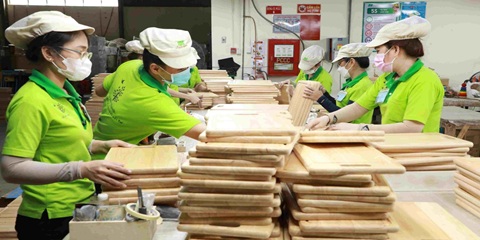Want to be in the loop?
subscribe to
our notification
Business News
INDUSTRIAL AND ECONOMIC ZONES READY TO ACCOMMODATE NEW FDI WAVE
Foreign investors are clearly moving their supply chains into Vietnam. In many localities, industrial parks, export processing zones and high-tech zones have prepared necessary conditions to accommodate this investment flow. Our reporter has an interview with Dr. Vo Tri Thanh, Director of the Institute for Brand and Competition Strategy. Thu Ha reports.
What do you think about the roles of economic zones, industrial parks and export processing zones in attracting foreign direct investment (FDI)?
The roles of economic zones, industrial parks and high-tech parks have been vividly illustrated by their important contributions to the country’s development, reflected in economic, environmental and social aspects.
The remarkable prosperity of the nation’s socioeconomic development in the doi moi (renovation) era has been deeply marked by industrial parks and economic zones. Throughout more than 30 years of development, industrial parks and economic zones have successfully attracted a large amount of domestic and foreign investment capital, improved the effect of land use, increased export value, created jobs and increased budget revenue.
According to a report by the Ministry of Planning and Investment, Vietnam had 369 industrial parks with a total area of 113,300 ha by the end of October 2020 (including industrial parks inside coastal economic zones and border economic zones), of which 73,600 ha is rentable industrial land (accounting for about 65% of the total land area). Industrial parks and economic zones across the country attracted 591 foreign investment projects with about US$8.3 billion of investment capital in the first 10 months of 2020. Industrial parks and economic zones are still considered the best approach to lure investment, and play an important role in the country’s industrial development process and socioeconomic development strategy.
In addition, tenants in industrial parks and economic zones continue to grow and develop, thus making greater contributions to socioeconomic development. Accumulatively, by the end of September 2020, they reported revenues of US$135.7 billion, the export value of US$10.1 billion (up 0.7% over the same period in 2019), and tax and fee payment of VND79.8 trillion (US$3.3 billion) to the State Budget (up 1% year on year). They employed 3.83 million workers.
Besides, with the formation of industrial parks and economic zones, industrial production in Vietnam has increased substantially. Industrial parks and economic zones have also helped promote infrastructure modernization, functioned as a nucleus to form new urban areas and helped environmental protection and sustainable ecosystems.
How has the infrastructure of industrial parks and economic zones improved to attract foreign investors and accommodate investment flows?
In addition to incentive policies, the infrastructure of industrial parks and economic zones is key to attract investment. Thus, the infrastructure system in industrial parks and economic zones across the country has been heavily invested. Centralized power supply, traffic, water supply, waste treatment and warehouse systems have been built to readily serve investors.
According to the Ministry of Planning and Investment, among 369 established industrial parks, 280 are in operation, covering 82,800 ha, of which rentable industrial land is 56,600 ha. They rented 39,800 ha (occupancy rate of 70.1%). 89 industrial parks are under construction, covering 30,500 ha of land, including 16,300 ha of rentable industrial area. Currently, 247 out of 280 operational industrial parks (88.2%) have centralized wastewater treatment facilities with a daily maximum capacity of over 1.1 million cubic meters of wastewater.
From 2020 onwards, as the investment flow shift is geared up, industrial parks should boost investment in building prefabricated factories with integrated services and new technologies for lease. Besides, this is expected to change industrial parks from the traditional model to service-based high-tech parks associated with modern urban areas, and prioritize eco-industrial parks and renewable energy industrial parks.
In addition to infrastructure development, human resource training policies for economic zones have been consistently applied among localities to ensure the supply of high-quality human resources for investors.
Industrial parks and economic zones have fostered the formation and development of peer clusters to develop production networks and value chains, enhance the capacity of supporting industries and the competitiveness of Vietnamese enterprises, especially in the context of the country's deep international integration and a strategic shift of quality FDI flows. What do you think about this?
To draw quality FDI flows and leading companies, industrial parks and economic zones not only need to prepare clean land, good human resources and highly internationally competitive incentives, but also need good approaches and policies on development of industry-related clusters. The most essential nature of an industry-specific cluster is the effective linkage of all stakeholders involved in production and business activities, value chains and supply chains, as well as the role of leading companies and small and medium-sized enterprises (SMEs).
In Vietnam, from the perspective of industry-specific industrial parks, many handicraft villages, industrial parks and economic zones are gathering similar and associated business fields into one place which is established and developed logically, without intentional intervention by the Government and local authorities. Tourism and oil and gas associated parks are formed and situated in areas with favorable natural conditions like Central Tourism Cluster, Southeast Oil and Gas Cluster or Mekong Delta Agricultural Product Cluster. Export processing zones are primarily concentrated in the south, especially areas around Ho Chi Minh City (for example, textile and garment, leather and footwear and electronics) while clusters of heavy industries, which tend to use much capital, tend to be in the north, particularly areas around Hanoi and neighboring provinces (for example, automobile and motorbike mechanical clusters, electronics and refrigeration clusters).
However, associated clusters still lack sustainability and cohesion, giving rise to limited impacts on tenants and outside companies. In addition, they lack specific long-term sustainable programs that have a truly useful impact on businesses.
What do you think about the development of eco-industrial parks?
Eco-industrial parks are increasingly recognized as an effective tool for sustainable development. This concept seems to be new but it is, in fact, a popular trend in many countries around the world such as China, South Korea, Japan, the United States, Australia and many European countries.
In essence, an eco-industrial park is a “colony” of closely-linked manufacturing and service companies that share the same interests, work toward high-quality social, economic and environmental activities, and advance cooperation in managing environmental and resource issues. With their close cooperation, the “colony” will achieve an overall effect much greater than the total combined effect of individual enterprises. Decree 82/2018/ND-CP of the Government on management of industrial parks and economic zones clearly states incentives for the development of eco-industrial parks and criteria for eco-industrial parks in Vietnam. Directing industrial parks toward eco-industrial parks is an expanding trend and helpful to Vietnam's green growth strategy.
The Ministry of Planning and Investment carried out a pilot project on three eco-industrial parks in Ninh Binh, Da Nang and Can Tho. After four years, 72 companies joining this project have applied resource efficient and cleaner production (RECP) solutions to enhance resource efficiency. These are the first steps to modern and sustainable development of eco-industrial parks.
Could you please tell us how to scale up this eco-industrial park model? In the coming time, what will economic zones, industrial parks, export processing zones and high-tech industrial parks need to prepare to capture redirected investment flows?
Applying eco-industrial parks in Vietnam is one solution toward green growth and sustainable development. However, to develop and replicate this model, the policy system plays a very important role. There must be multi-stakeholder cooperation of government, business, community, researchers and consumers.
For State administration, competent agencies from central to local levels, especially managers of this model, need to have a clear awareness of the concept, benefits and conditions to transform them into eco-industrial parks. Besides, there must be a legal basis for relevant agencies to implement this model.
From a business perspective, it is necessary to understand benefits of this model and understand strategic directions of the Government.
Another important factor is the need for a preferential loan mechanism, enabling businesses to easily access capital to have more opportunities to apply technology and solutions for efficient use of resources and cleaner production.
While promoting and scaling up eco-industrial parks, given that redirected investment flows are increasingly clear, industrial parks and economic zones need to prepare sufficient clean ground and build new industrial parks and export processing zones with full technical and social infrastructure.
In particular, they may consider reducing administrative procedures for displaced FDI factories to save time, quickly go into operation after being relocated and reduce costs for businesses. They need to assign priority to developing logistics systems and simplifying import and export procedures to minimize logistics costs in Vietnam. Currently, the Ministry of Planning and Investment proposed four groups of solutions, including: Investment promotion; quality investment attraction; investment climate improvement and ready preparations to welcome investors, and investment supports and incentives. The revised Investment Law and other related laws have added competitive incentives to create more favorable conditions for investors.
Source: VCCI
Related News

A STELLAR CHRISTMAS AT SOFITEL SAIGON PLAZA
Experience the magic of year-end celebrations in five-star luxury, where Parisian elegance meets Saigon’s festive vibrancy. Discover your Stellar Christmas moments: https://sofitel-saigon-plaza.com/festive-offer-2025

CONSTRUCTION SECTOR POSTS OVER 9% GROWTH IN 2025
Industries under the ministry’s management accounted for an estimated 17.23% of national gross domestic product (GDP), up about 0.17 percentage point from 2024. They contributed around 1.96 percentage points to overall GDP growth, reported the Vietnam News Agency. The contribution helped push Vietnam’s economic growth to above 8% in 2025 and supports the Government’s aim of pursuing double-digit growth in the coming years.

VIETNAM PUTS PUBLIC INVESTMENT DISBURSEMENTS AT VND603.6 TRILLION
Vietnam’s public investment disbursements had amounted to VND603.6 trillion in the year to December 18, equivalent to 66.1% of the plan assigned by the prime minister. According to the Ministry of Finance, actual disbursements by December 11 had totaled VND577.7 trillion, or 63.3% of the prime minister-approved plan of VND913.2 trillion, the Vietnam News Agency reported.

SHINE INTO 2026 AT HOIANA RESORT & GOLF!
This New Year’s Eve, celebrate where the sea meets the sky. Vibrant performances, festive dining, DJ beats, live bands and dazzling fireworks come together for one unforgettable night. From beachfront countdown moments to curated New Year’s Eve dinners across Hoiana, every detail is designed to welcome 2026 in style.

VIETNAM’S TRADE SET TO SURPASS US$900 BILLION FOR FIRST TIME
Vietnam’s total import-export turnover is expected to reach about US$920 billion by the end of the year, marking the first time the country’s trade value has exceeded the US$900-billion mark. As of December 15, Vietnam’s total trade turnover stood at US$883.7 billion, according to the Agency of Foreign Trade under the Ministry of Industry and Trade.

GLOBAL SOURCING FAIR VIETNAM 2026 – THE TRULY GLOBAL B2B SOURCING SHOW IN VIETNAM TO EXPAND & DIVERSIFY YOUR EXPORT MARKETS WORLDWIDE
The 4th edition of Global Sourcing Fair Vietnam returns in 2026 with an impressive scale, featuring 700 booths showcasing Fashion & Accessories, Home & Gifts, and the newly introduced Printing & Packaging Products from 500+ verified suppliers across Vietnam and Asia – including Mainland China, Taiwan, Hong Kong SAR, South Korea, India, Bangladesh, ASEAN, and more.
























